5. A Fresh Way to View Your Photos
Kawamoto-san, how did you feel when you were asked to create a Wii Channel, after having produced two Brain Training titles which proved to be exceedingly popular? Did you wonder why you hadn't been asked to develop a regular game?
I'd be lying if I said that thought hadn't crossed my mind! (laughs) But as someone with a small son and daughter, I naturally take a lot of pictures of them which I then sort and view on my laptop. I know how troublesome that can be, so I was very interested in the opportunity to develop the Photo Channel. If you show photos to children on a laptop, they're more interested in playing with the keyboard. That's why when Iwata-san gave me the concept of seeing digital camera pictures on the TV screen, I knew exactly what we should be aiming for. In a sense, I was happy when you asked me to develop this Channel, as this was something I had wanted myself.
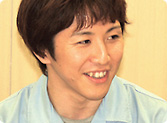
That might be the reason why the time between me asking you to work on the project and the completion of the prototype version was so short! I was genuinely surprised that you were able to produce it that quickly.
I think the reason for that was that I use my digital camera all the time and often wonder why things couldn't be more like this, or that. That's why I had a clear idea of how to approach the project.
What's more, the fundamental structure and style of the finished Channel were already present from the prototype stage. Of course, there was a little fine-tuning to be done...
The basic set-up for viewing photos, zooming in and out, the pixelating and even the Slide show features were all in place from the earliest stages of development.
Of all the Channels, this is the one which was the most fully-formed at the earliest stages of the project. When people were shown the Photo Channel, they realised what Wii is actually capable of, and in this sense it spurred on the development of all the other Channels. This is similar to what happened when Kawamoto-san and I began developing Brain Training.
Yes, there are similarities. At that time, looking at the available DS software, I was always wondering why there were no titles where all you have to do is write on the screen. Then Iwata-san asked me to develop arithmetic software, which would later become Brain Training's Calculations x 20 mode.
When they were asked to adapt Dr Kawashima's ideas for the DS, the first thing Kawamoto-san and his team came up with was Calculations x 20. The prototype at that stage was also very close to the finished article.
There was a lot of fine-tuning remaining to be done, but the basic structure was in place, and the enjoyment felt when you gave it a try was there from the start.
Kawamoto-san, you're a software director, but you have your roots in programming. This ability to program is a great strength. In other words, if you have an idea, you can actually put it into action yourself without having to draw up a specification document plan, or anything like that. This makes things a lot faster. Since I also have a background in programming, I can really understand where you're coming from.
That's the first time I've heard that! (laughs) That's one way of looking at it.
What did you pay particular attention to when developing the Photo Channel?
For me, it was important that someone with no technical knowledge would be able to pick it up and use it. I think the experience of working on Brain Training influenced me here. This is getting a bit detailed but, on Brain Training, the game was conceived from the start to be controlled using the Touch Screen. We therefore had a number of buttons on the screen which clearly indicated to the user what would happen if they touched them. If Brain Training had used conventional controls, in other words, the +Control Pad and a number of buttons, then anyone who used it would first need to understand what each button does. Using Touch Screen controls on the other hand means that the user can simply press the button they want directly. The most vital thing is to ensure the user knows exactly what is going to happen when they push a particular button. That ease of use which we had been seeking for Brain Training was something we were able to bring to Wii. Specifically, I insisted that we did everything we could to eliminate anything confusing from the screen. This enabled people to use the scrolling and zooming in and out controls intuitively, even if it was their first time. As I worked on this project, I always had the image of a family of four or so sitting around the TV, laughing and having a good time. This meant that I made absolutely sure that, for instance, there were no difficult words on-screen. This was the same as Brain Training.
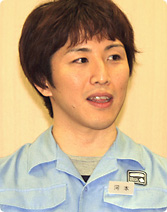
What really impressed me about the Photo Channel was the incredibly light feel it had. I was surprised at how easy it was to view pictures on Wii. There is a lot of software for the PC that allow you to view and edit photos, and although they come with a vast number of features, none of them compare to Wii in that real feeling of lightness in the controls. When I experienced this on the Photo Channel, I realised that this was something fundamentally different from the way things work on the PC.
It's a real pain having to wait for the computer to load your photos. That's why I got my team to make every effort to reduce the time required to load the photos as much as possible.
This is something that is very well hidden in the Channel, thanks to the programming. Another thing to mention is that you can also watch videos on the finished version of the Photo Channel. That was something which wasn't on the list of features originally requested. What prompted you to include this feature?
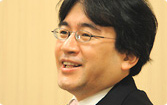
I thought from the outset that we would have to make it possible to watch videos. Almost all digital cameras now can record videos, so we needed to accomodate that. Another major motivation was that I wanted to watch clips of my own children babbling on Wii! (laughs) At present, we plan to make the Channel compatible with the MotionJPEG format. The other feature I planned to include from the start was a pixellating function for video clips. I was responsible for artistic effects on Mario Artist: Talent Studio for the Nintendo 64DD. I remembered the pixelating effect (similar to the effect used on TV to hide people's identities) we used on that, and were able to implement it into the Photo Channel quickly. I find that people respond well when I show it to them.
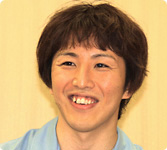
It provokes a great reaction during Wii presentations!
I usually use this effect on your face when giving presentations! (laughs)
That always gets a laugh, whether it's people inside or outside the company!
(laughter)
Something else we added towards the end of the project is the function enabling the user to draw on the photographs. As the Wii Remote allows you to simply point where you want on the screen, you naturally want to try to draw pictures. We gave that a try, but as expected it turned out to be difficult to draw proper pictures on-screen. But it is possible to do graffiti and scribbling, such as drawing eyebrows onto people's faces, or making simple photo montages.
In the company, what feature provoked the biggest reaction?
It wasn't so much a particular feature, but everyone really liked just simply seeing digital camera pictures up on a big screen. While it's possible to hook up most digital cameras to a TV, I don't think many people do it.
Yes, I've never actually seen anyone who had connected their digital camera to their TV.
I've given it a go a few times, but every time I want to show some pictures to my children, they always wander off somewhere while I'm fiddling around with the cables! (laughs)
I'm sure that for many people, just being able to see their digital camera pictures on the big screen will feel really fresh. Pictures they've only ever seen either scrolling through them on a 2 or 3 inch screen or on their computer, they'll be able to easily view them on their living room TV. People will get into the habit of sticking their SD Card into the Wii as soon as they get home after they've taken pictures. I think that will change the way people view digital camera photographs.
Another thing which people have really enjoyed is the Slide show function. This allows you to play music as the console automatically displays your pictures in turn. If you put MP3 files in your SD Card, you can have your favourite songs as background music to your Slide show.
We were all quite impressed when you gave us a demonstration of the Slide show. You applied a sepia effect to all the photos and accompanied them with "Chijo no Hoshi" by Miyuki Nakajima, the theme song to "Project X" (a popular Japanese TV show about inventors). (laughs)
Well, all the pictures I used were of developers working on Wii, so when I added the soundtrack, it looked just like an episode from "Project X!"
(laughter)
A photo's mood will change simply by switching the music. I was careful, however, not to allow the photos to be upstaged. I mean, it would have been easy to make a flashy, stylish Slide show, but a lot of people felt that this would distract the viewer from the photos, which are after all the most important part of the show.
Kawamoto-san, as well as the Photo Channel, you were responsible for the Forecast and News Channels. Tell us a little about the production of these Channels.
Certainly. Like the Photo Channel, the concepts behind the Forecast and News Channels emerged out of our discussions concerning what kind of Channels would be used by people who don't normally play games. And again, out of the blue you ordered us to make a prototype! (laughs)
Sorry, I keep doing that, don't I? (laughs)
No, no. I appreciate it!
To be honest, I think you really enjoy making those prototypes.
I do, but I'd love to be able to spend a bit more time on them…
(laughter)
So, what ideas did you come up with for the News and Forecast Channels?
Well, I was quite particular about the responsive control method you talked about earlier. I mean, I wanted the user to be able to navigate through these Channels very smoothly. I also realised that it wouldn't be interesting to simply display the weather. After all, Wii is an entertainment system.
You can view weather information at the touch of a button if you have digital TV, can't you?
Exactly. I wanted to do something that TV can't do. So, I tried displaying the entire planet on-screen, thereby allowing the user to see the weather all around the world by spinning it with the Wii Remote.
Needless to say, this feature was not in the specs when I first asked you to create the Forecast Channel, right?
No, not at all.
But you just wanted to play around, spinning a globe, didn't you? (laughs)
Basically, yes! (laughs)
The globe feature may seem a bit pointless, but everyone really enjoys it when you let them have a go. Kuroume-san, what did you think when you first saw it?
It had quite an impact. As a fellow developer, I couldn't help but grudgingly admire it!
It's wonderful to see all those weather icons spreading out across the world when you zoom out. You know at a glance what the weather's doing anywhere. You can see, for example, whether it's particularly hot in a certain part of the world.
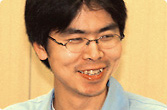
And what ideas did you have for the News Channel?
Well, there was the smooth enlarging and reduction of text size, and the pointing out of places that appear in the news.
Using that globe again! (laughs)
Yes, it's quite good fun really. That aside, we plan for this news and weather data to be updated regularly.
This was also cause for discussion. Some people felt that it would be sufficient for the user to go to the relevant page after turning on the power, but I really felt that it was important for the news to be displayed as soon as Wii is started up. A few seconds can make a big difference when you want to know something right away.
Yes. Hardcore gamers might not be overly excited when they hear about the News and Forecast Channels, but I think we've come up with some really useful features.
